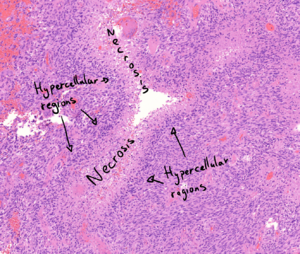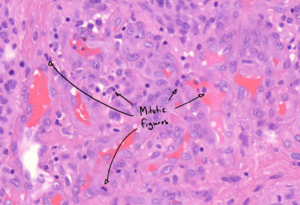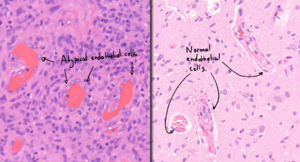22. Glioblastoma: Difference between revisions
(Created page with "'''Staining''': HE '''Organ''': Brain '''Description''': There are four important characteristics in glioblastomas: * Severe atypia * Many mitotic figures * Pseudopalisading necrosis * Microvascular proliferation Microvascular proliferation is a phenomenon where the tumor contains small capillaries who are irregular and are comprised of atypical endothelial cells. Pseudopalisading necrosis is a phenomenon where the tumor contains areas of necrosis, and this necrosi...") |
(No difference)
|
Revision as of 21:40, 3 November 2022
Staining: HE
Organ: Brain
Description:
There are four important characteristics in glioblastomas:
- Severe atypia
- Many mitotic figures
- Pseudopalisading necrosis
- Microvascular proliferation
Microvascular proliferation is a phenomenon where the tumor contains small capillaries who are irregular and are comprised of atypical endothelial cells.
Pseudopalisading necrosis is a phenomenon where the tumor contains areas of necrosis, and this necrosis is surrounded by hypercellular regions.
Diagnosis: Glioblastoma
Risk factors:
- Age 50 – 70
Theory:
Glioblastoma is a grade IV astrocytic tumor that is defined histologically be the four characteristics described above. It must be differentiated from anaplastic astrocytoma, a grade III astrocytic tumor. Anaplastic astrocytoma also shows severe atypia and many mitotic figures but no pseudopalisading necrosis or microvascular proliferation.




